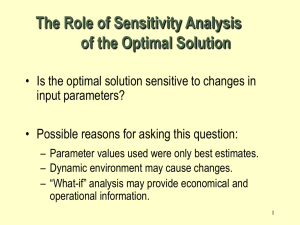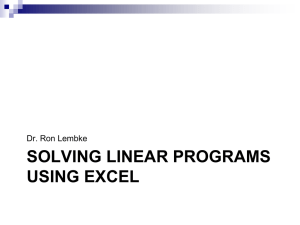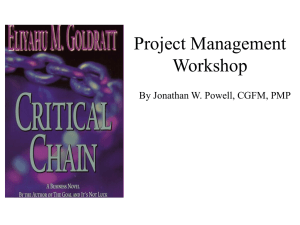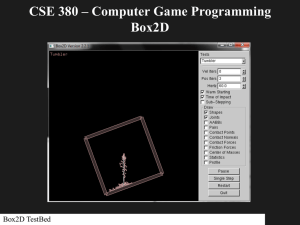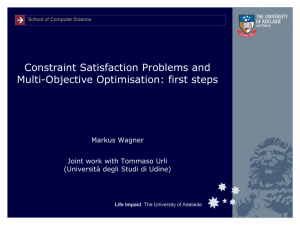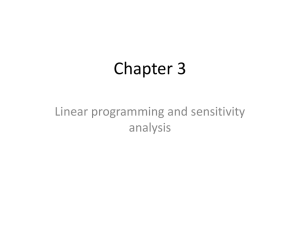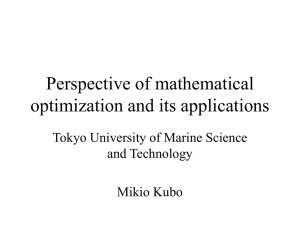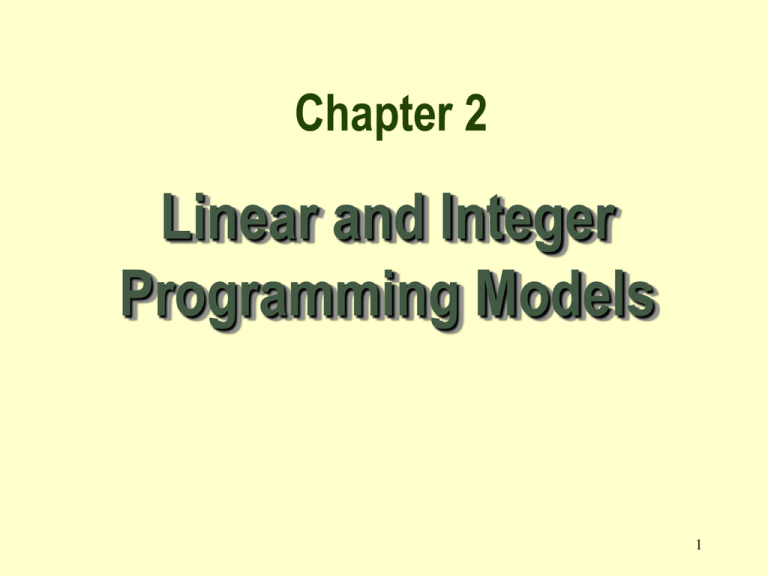
Chapter 2
Linear and Integer
Programming Models
1
2.1 Introduction to Linear Programming
• A Linear Programming model seeks to maximize or
minimize a linear function, subject to a set of linear
constraints.
• The linear model consists of the following
components:
– A set of decision variables.
– An objective function.
– A set of constraints.
2
Introduction to Linear Programming
• The Importance of Linear Programming
– Many real world problems lend themselves to linear programming
modeling.
– Many real world problems can be approximated by linear models.
– There are well-known successful applications in:
• Manufacturing
• Marketing
• Finance (investment)
• Advertising
• Agriculture
3
Introduction to Linear Programming
• The Importance of Linear Programming
– There are efficient solution techniques that solve linear
programming models.
– The output generated from linear programming packages
provides useful “what if” analysis.
4
Introduction to Linear Programming
• Assumptions of the linear programming model
– The parameter values are known with certainty.
– The objective function and constraints exhibit
constant returns to scale.
– The Additivity assumption): There are no
interactions between the decision variables.
– The Continuity assumption: Variables can take on
any value within a given feasible range.
5
The Galaxy Industries Production Problem –
A Prototype Example
• Galaxy manufactures two toy doll models:
– Space Ray.
– Zapper.
• Two resources are used in the production
process. The resources are limited to
– 1000 pounds of special plastic.
– 40 hours of production time per week.
6
The Galaxy Industries Production Problem –
A Prototype Example
• Marketing requirement
– Total production cannot exceed 700 dozens.
– Number of dozens of Space Rays cannot exceed
number of dozens of Zappers by more than 350.
• Technological input
– Space Rays requires 2 pounds of plastic and
3 minutes of labor per dozen.
– Zappers requires 1 pound of plastic and
4 minutes of labor per dozen.
7
The Galaxy Industries Production Problem –
A Prototype Example
• The current production plan calls for:
– Producing as much as possible of the more profitable product,
Space Ray ($8 profit per dozen).
– Use resources left over to produce Zappers ($5 profit
per dozen), while remaining within the marketing guidelines.
• The current production plan consists of:
8(450) + 5(100)
Space Rays = 450 dozen
Zapper
= 100 dozen
Profit
= $4100 per week
8
Management is seeking a
production schedule that will
increase the company’s profit.
9
A linear programming model
can provide an insight and an
intelligent solution to this problem.
10
The Galaxy Linear Programming Model
• Decisions variables:
– X1 = Weekly production level of Space Rays (in dozens)
– X2 = Weekly production level of Zappers (in dozens).
• Objective Function:
– Weekly profit, to be maximized
11
The Galaxy Linear Programming Model
Max 8X1 + 5X2
subject to
2X1 + 1X2 1000
3X1 + 4X2 2400
X1 + X2 700
X1 - X2 350
Xj> = 0, j = 1,2
(Weekly profit)
(Plastic)
(Production Time)
(Total production)
(Mix)
(Nonnegativity)
12
2.3 The Graphical Analysis of Linear
Programming
The set of all points that satisfy all the
constraints of the model is called
a
FEASIBLE REGION
13
Using a graphical presentation
we can represent all the constraints,
the objective function, and the three
types of feasible points.
14
Graphical Analysis – the Feasible Region
X2
The non-negativity constraints
X1
15
Graphical Analysis – the Feasible Region
X2
The Plastic constraint
2X1+X2 1000
1000
Total production constraint:
X1+X2 700 (redundant)
700
500
Infeasible
Production
Time
3X1+4X2 2400
Feasible
500
700
X1
16
Graphical Analysis – the Feasible Region
X2
1000
The Plastic constraint
2X1+X2 1000
Total production constraint:
X1+X2 700 (redundant)
700
500
Production
Time
3X1+4X22400
Infeasible
Production mix
constraint:
X1-X2 350
Feasible
500
700
X1
Interior points. Boundary points. Extreme points.
• There are three types of feasible points
17
Solving Graphically for an
Optimal Solution
18
The search for an optimal solution
X2
1000
Start at some arbitrary profit, say profit = $2,000...
Then increase the profit, if possible...
...and continue until it becomes infeasible
Profit =$4360
700
= 8(320) + 5(360)
500
360
X1
320
19
500
Summary of the optimal solution
Space Rays = 320 dozen
Zappers
= 360 dozen
Profit = $4360
– This solution utilizes all the plastic and all the production hours.
– Total production is only 680 (not 700).
– Space Rays production is set at a level of 40 dozens below
Zappers.
20
Extreme points and optimal solutions
– If a linear programming problem has an optimal
solution, an extreme point is optimal.
21
Multiple optimal solutions
• For multiple optimal solutions to exist, the objective
function must be parallel to one of the constraints
•Any weighted average of
optimal solutions is also an
optimal solution.
22
2.4 The Role of Sensitivity Analysis
of the Optimal Solution
• Is the optimal solution sensitive to changes in
input parameters?
• Possible reasons for asking this question:
– Parameter values used were only best estimates.
– Dynamic environment may cause changes.
– “What-if” analysis may provide economical and
operational information.
23
Sensitivity Analysis of
Objective Function Coefficients.
•
Range of Optimality
– The optimal solution will remain unchanged as long as
• An objective function coefficient lies within its range of
optimality
• There are no changes in any other input parameters.
– The value of the objective function will change if the
coefficient multiplies a variable whose value is nonzero.
24
Sensitivity Analysis of
Objective Function Coefficients.
1000
X2
500
X1
25
500
800
1000
Sensitivity Analysis of
Objective
Function
Coefficients.
X
2
Range of optimality: [3.75, 10]
500
400
600
800
X1
26
• Reduced cost
Assuming there are no other changes to the input parameters,
the reduced cost for a variable Xj that has a value of “0” at the
optimal solution is:
– The negative of the objective coefficient increase of the variable
Xj (-DCj) necessary for the variable to be positive in the optimal
solution
– Alternatively, it is the change in the objective value per unit
increase of Xj.
• Complementary slackness
At the optimal solution, either the value of a variable is zero, or
its reduced cost is 0.
27
Sensitivity Analysis of
Right-Hand Side Values
• In sensitivity analysis of right-hand sides of constraints
we are interested in the following questions:
– Keeping all other factors the same, how much would the
optimal value of the objective function (for example, the profit)
change if the right-hand side of a constraint changed by one
unit?
– For how many additional or fewer units will this per unit
change be valid?
28
Sensitivity Analysis of
Right-Hand Side Values
• Any change to the right hand side of a binding
constraint will change the optimal solution.
• Any change to the right-hand side of a nonbinding constraint that is less than its slack or
surplus, will cause no change in the optimal
solution.
29
Shadow Prices
• Assuming there are no other changes to the
input parameters, the change to the objective
function value per unit increase to a right hand
side of a constraint is called the “Shadow Price”
30
Shadow Price – graphical demonstration
The Plastic
constraint
1000
X2
When more plastic becomes available (the
plastic constraint is relaxed), the right hand
side of the plastic constraint increases.
Maximum profit = $4360
500
Maximum profit = $4363.4
Shadow price =
4363.40 – 4360.00 = 3.40
Production time
constraint
X1
500
31
Range of Feasibility
• Assuming there are no other changes to the
input parameters, the range of feasibility is
– The range of values for a right hand side of a constraint, in
which the shadow prices for the constraints remain
unchanged.
– In the range of feasibility the objective function value changes
as follows:
Change in objective value =
[Shadow price][Change in the right hand side value]
32
The Plastic
constraint
1000
Production mix
constraint
X1 + X2 700
Range of Feasibility
X2
Increasing the amount of
plastic is only effective until a
new constraint becomes active.
A new active
constraint
500
This is an infeasible solution
Production time
constraint
X1
500
33
The Plastic
constraint
1000
Range of Feasibility
X2
Note how the profit increases
as the amount of plastic
increases.
500
Production time
constraint
X1
500
34
Range of Feasibility
X2
Infeasible
solution
1000
Less plastic becomes available (the
plastic constraint is more restrictive).
The profit decreases
500
A new active
constraint
X1
500
35
The correct interpretation of shadow prices
– Sunk costs: The shadow price is the value of an
extra unit of the resource, since the cost of the
resource is not included in the calculation of the
objective function coefficient.
– Included costs: The shadow price is the premium
value above the existing unit value for the resource,
since the cost of the resource is included in the
calculation of the objective function coefficient.
36
Other Post - Optimality Changes
• Addition of a constraint.
• Deletion of a constraint.
• Addition of a variable.
• Deletion of a variable.
• Changes in the left - hand side coefficients.
37
2.5 Using Excel Solver to Find an
Optimal Solution and Analyze Results
• To see the input screen in Excel click Galaxy.xls
• Click Solver to obtain the following dialog box.
This cell contains
Set Target cell
$D$6
the value of the
Equal To:
objective function
By Changing cells
These cells contain
$B$4:$C$4
the decision variables
To enter constraints click…
All the constraints
have the same direction,
thus are included in
one “Excel constraint”.
$D$7:$D$10
$F$7:$F$10
38
Using Excel Solver
• To see the input screen in Excel click Galaxy.xls
• Click Solver to obtain the following dialog box.
This cell contains
Set Target cell
$D$6
the value of the
Equal To:
objective function
By Changing cells
These cells contain
$B$4:$C$4
the decision variables
Click on ‘Options’
and check ‘Linear
Programming’ and
‘Non-negative’.
$D$7:$D$10<=$F$7:$F$10
39
Using Excel Solver
• To see the input screen in Excel click Galaxy.xls
• Click Solver to obtain the following dialog box.
Set Target cell
$D$6
Equal To:
By Changing cells
$B$4:$C$4
$D$7:$D$10<=$F$7:$F$10
40
Using Excel Solver – Optimal Solution
GALAXY INDUSTRIES
Dozens
Profit
Plastic
Prod. Time
Total
Mix
Space Rays
320
8
2
3
1
1
Zappers
360
5
1
4
1
-1
Total
4360
1000
2400
680
-40
Limit
<=
<=
<=
<=
1000
2400
700
350
41
Using Excel Solver – Optimal Solution
GALAXY INDUSTRIES
Dozens
Profit
Plastic
Prod. Time
Total
Mix
Space Rays
320
8
2
3
1
1
Zappers
360
5
1
4
1
-1
Total
4360
1000
2400
680
-40
Limit
<=
<=
<=
<=
1000
2400
700
350
Solver is ready to provide
reports to analyze the
optimal solution.
42
Using Excel Solver –Answer Report
Microsoft Excel 9.0 Answer Report
Worksheet: [Galaxy.xls]Galaxy
Report Created: 11/12/2001 8:02:06 PM
Target Cell (Max)
Cell
Name
$D$6 Profit Total
Original Value
4360
Final Value
4360
Adjustable Cells
Cell
Name
Original Value
$B$4 Dozens Space Rays
320
$C$4 Dozens Zappers
360
Final Value
320
360
Constraints
Cell
Name
$D$7 Plastic Total
$D$8 Prod. Time Total
$D$9 Total Total
$D$10 Mix Total
Cell Value
1000
2400
680
-40
Formula
$D$7<=$F$7
$D$8<=$F$8
$D$9<=$F$9
$D$10<=$F$10
Status
Slack
Binding
0
Binding
0
Not Binding
20
Not Binding
390
43
Using Excel Solver –Sensitivity
Report
Microsoft Excel Sensitivity Report
Worksheet: [Galaxy.xls]Sheet1
Report Created:
Adjustable Cells
Final Reduced Objective Allowable Allowable
Cell
Name
Value
Cost
Coefficient Increase
Decrease
$B$4 Dozens Space Rays
320
0
8
2
4.25
$C$4 Dozens Zappers
360
0
5 5.666666667
1
Constraints
Cell
$D$7
$D$8
$D$9
$D$10
Name
Plastic Total
Prod. Time Total
Total Total
Mix Total
Final Shadow Constraint Allowable Allowable
Value
Price
R.H. Side
Increase
Decrease
1000
3.4
1000
100
400
2400
0.4
2400
100
650
680
0
700
1E+30
20
-40
0
350
1E+30
390
44
2.7 Models Without Unique Optimal
Solutions
• Infeasibility: Occurs when a model has no feasible
point.
• Unboundness: Occurs when the objective can become
infinitely large (max), or infinitely small (min).
• Alternate solution: Occurs when more than one point
optimizes the objective function
45
Infeasible Model
No point, simultaneously,
lies both above line 1 and
below lines 2 and 3
.
2
3
1
46
Solver – Infeasible Model
47
Unbounded solution
48
Solver – Unbounded solution
49
Solver – An Alternate Optimal Solution
• Solver does not alert the user to the existence of
alternate optimal solutions.
• Many times alternate optimal solutions exist
when the allowable increase or allowable
decrease is equal to zero.
• In these cases, we can find alternate optimal
solutions using Solver by the following
procedure:
50
Solver – An Alternate Optimal Solution
• Observe that for some variable Xj the
Allowable increase = 0, or
Allowable decrease = 0.
• Add a constraint of the form:
Objective function = Current optimal value.
• If Allowable increase = 0, change the objective to
Maximize Xj
• If Allowable decrease = 0, change the objective to
Minimize Xj
51
2.8 Cost Minimization Diet Problem
• Mix two sea ration products: Texfoods, Calration.
• Minimize the total cost of the mix.
• Meet the minimum requirements of Vitamin A,
Vitamin D, and Iron.
52
Cost Minimization Diet Problem
• Decision variables
– X1 (X2) -- The number of two-ounce portions of
Texfoods (Calration) product used in a serving.
• The Model
Minimize 0.60X1 + 0.50X2
Cost per 2 oz.
Subject to
20X1 + 50X2 100 Vitamin A
25X1 + 25X2 100 Vitamin D
% Vitamin A
provided per 2 oz.
50X1 + 10X2 100 Iron
% required
X1, X2 0
53
The Diet Problem - Graphical solution
10
The Iron constraint
Feasible Region
Vitamin “D” constraint
Vitamin “A” constraint
2
4
5
54
Cost Minimization Diet Problem
• Summary of the optimal solution
– Texfood product = 1.5 portions (= 3 ounces)
Calration product = 2.5 portions (= 5 ounces)
– Cost =$ 2.15 per serving.
– The minimum requirement for Vitamin D and iron are met with
no surplus.
– The mixture provides 155% of the requirement for Vitamin A.
55
Computer Solution of Linear Programs With
Any Number of Decision Variables
• Linear programming software packages solve
large linear models.
• Most of the software packages use the algebraic
technique called the Simplex algorithm.
• The input to any package includes:
– The objective function criterion (Max or Min).
– The type of each constraint: , , .
– The actual coefficients for the problem.
56
Copyright 2002 John Wiley & Sons, Inc. All rights
reserved. Reproduction or translation of this work beyond that
named in Section 117 of the United States Copyright Act
without the express written consent of the copyright owner is
unlawful. Requests for further information should be
addressed to the Permissions Department, John Wiley & Sons,
Inc. Adopters of the textbook are granted permission to make
back-up copies for their own use only, to make copies for
distribution to students of the course the textbook is used in,
and to modify this material to best suit their instructional
needs. Under no circumstances can copies be made for resale.
The Publisher assumes no responsibility for errors, omissions,
or damages, caused by the use of these programs or from the
use of the information contained herein.
57

